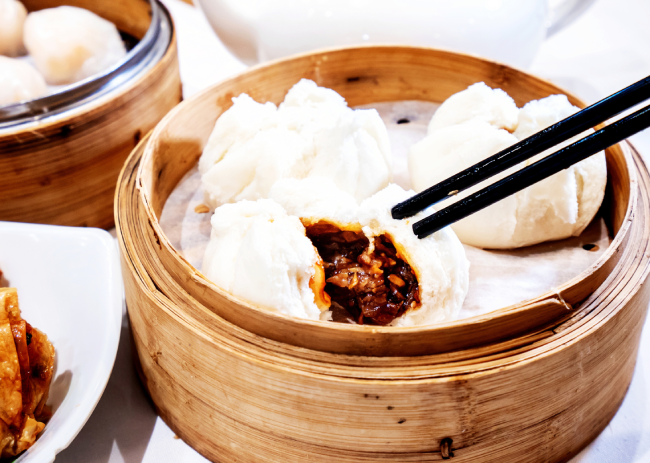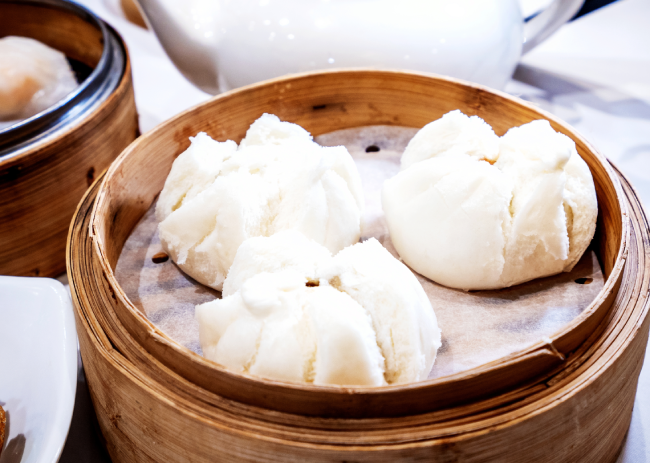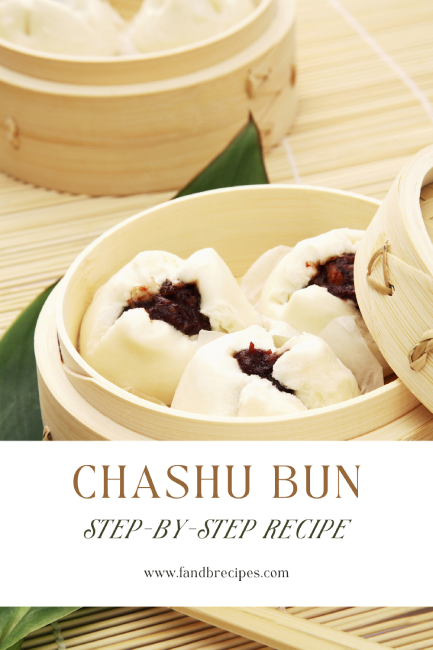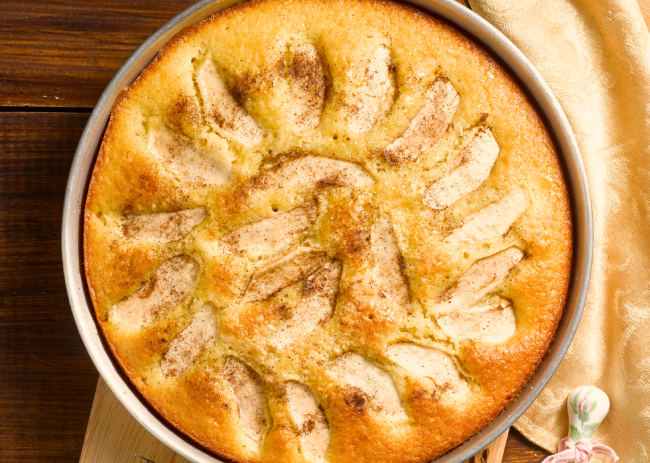Chashu Bun: Step-By-Step Recipe
Chashu Bun is a popular Japanese meal that you can find in countries such as Japan, Korea, and Taiwan. The dish consists of light, fluffy buns filled with “Chashu”, a sweet and savoury pork filling. Many people enjoy it because of the ideal blend of flavours and textures.
All-purpose flour, cornflour, yeast, and baking powder combine to make soft, fluffy buns. These ingredients mix together to make a dough kneaded until smooth and elastic. The dough is then allowed to rest and rise for a few hours, yielding soft and fluffy buns that are ideal for steaming.
The filling for Chashu Bao is created from diced Chinese roast pork. It cooks with a delectable blend of sauces and seasonings, for instance, oyster sauce, soy sauce, black soy sauce and sesame oil are included, as well as sugar and chicken stock. The mix of these flavours results in a sweet and savoury filling. It complements the soft and fluffy buns in a nice way.
It’s time to construct the Chashu Bao after the buns have steamed and the filling has cooked. Each bun then fills with pork filling before being pleated and moulds to form a closed top. The buns then cook one more time, yielding a tasty and gratifying supper. It makes it suitable for any occasion.
Finally, Chashu is sure to impress if you’re a fan of Japanese cuisine or searching for a new and fascinating meal. It’s a popular dish for good reason. The mix of soft and fluffy buns with the sweet and savoury pork filling is a culinary marriage made in heaven.
What Is A Chashu Bun?
A Chashu Bun, also known as a pork belly bun, is a traditional Japanese cuisine. It has gained worldwide popularity. This savoury street dish cooks out of a soft and fluffy steamed bun. Stuffed with slices of braised pork belly flavoured with a rich soy sauce and mirin glaze. The pork belly then cooks for several hours until tender and flavourful. It makes the ideal stuffing for the soft and pillowy steamed bun.
Furthermore, Chashu Buns are a popular meal at many Asian restaurants and street vendors around the world.
A Chashu Bun is a delicious and satisfying Japanese street food. It consists of a soft and fluffy steamed bun filled with slices of braised pork belly flavoured with a rich soy sauce and mirin glaze. It has bold flavours and contrasting textures. Chashu Buns became a beloved comfort food around the world.
Why This Recipe Works
This Chashu Bun recipe succeeds because it balances savoury and sweet flavours. The pork belly is marinated in a fragrant soy sauce and mirin glaze. It imparts a deep and savoury flavour to the meat. The glaze also contains sugar and other seasonings, which give the pork a hint of sweetness and serve to balance out the flavours.
The soft and fluffy steamed buns used in this dish give a nice contrast to the savoury. The buns produce a simple dough that rises, resulting in a light and airy texture. Moreover, Steaming the buns also keeps them moist and delicate. Steaming makes them the perfect vessel for the flavourful pork filling
Further, the addition of cucumber and scallions to the Chashu Bun adds a refreshing and crisp element to the dish. It helps to cut through the richness of the pork and adds some more texture. The hoisin sauce or sesame seeds added to the top of the bun provide one more layer of flavour and texture. This will make the dish a complex and satisfying meal.
Ingredients Required to Make Chashu Bun
To prepare a batter for steaming Cha Siu Baos:
- 5 tablespoons sugar: Balances the flavours and imparts a mild sweetness to the dough.
- 1 teaspoon dried fresh yeast: This yeast type needs activation before use, aiding the dough to rise and become fluffy.
- ¾ cup hot water: Activates the yeast and helps bind the dough.
- 1-2 teaspoons water (optional): Used if the dough requires more moisture to come together.
- 2 cups of general-purpose flour: The primary ingredient for the dough, providing structure and texture.
- ¼ cup vegetable or canola oil: Keeps the dough moist and tender.
- 1 cup cornstarch: Adds a soft and tender texture to the dough.
- 2 ½ teaspoons of baking powder: Helps the dough rise and become fluffy.
Filling for cooked buns:
- ⅓ cup finely chopped onion: Adds flavour and texture to the filling.
- 1 tablespoon of oil: Used to cook the finely chopped shallots or red onions for the filling.
- 1 ½ tablespoons oyster sauce: A thick, savoury sauce made from oysters that adds depth to the filling.
- 1 tablespoon fine soy sauce: Provides a savoury and salty flavour.
- 1 tablespoon sugar: Balances flavours and imparts mild sweetness to the filling.
- 2 teaspoons vegetable oil: Adds a nutty and aromatic touch.
- 2 tablespoons all-purpose flour: Used as a thickening agent for the filling.
- 2 teaspoons soy sauce that is dark: Adds rich, dark colour and intense flavour to the filling.
- ½ cup chicken broth: Provides moisture and helps bind the ingredients together.
- 1 ½ cups Chinese grilled pork, diced: The star ingredient, marinated in a mixture of soy sauce, hoisin sauce, honey, and other seasonings, then roasted until tender and caramelized. It provides a sweet and savoury flavour to the filling.
Tools Required to Make a Chashu Bun
To make a Chashu Bun, you will need a few essential tools and equipment. These include:
- Steamer: A steamer is necessary for steaming the buns. You can use a bamboo steamer, a metal steamer, or an electric steamer.
- Mixing Bowls: You will need mixing bowls to prepare the dough for the steamed buns and to marinate the pork belly.
- Measuring Cups and Spoons: These are necessary for measuring out the accurate amount of ingredients.
- Rolling Pin: A rolling pin is necessary to roll out the dough for the steamed buns to the desired thickness.
- Cutting Board: You will need a cutting board to slice the pork belly and chop the cucumber and scallions.
- Chef’s Knife: A sharp chef’s knife is necessary to slice the pork belly and chop the cucumber and scallions.
- Pot or Dutch Oven: A pot or Dutch oven is necessary to braise the pork belly in the marinade.
- Tongs: Tongs are helpful for removing the pork belly from the pot and placing it in the steamed buns.
- Brush: A pastry brush is helpful for brushing the hoisin sauce onto the steamed buns.
In conclusion, these are the essential tools and equipment required to make a Chashu Bun. Having these tools on hand will make the process of making this delicious dish much easier.
Chashu Bun Recipe
Serve these incredible Cashu Buns (Char Siu Baos) as an appetizer or a fantastic meal for entertaining.
Servings: 10 Prep Time: 3 hours Cook Time: 30 minutes Total Time: 3 hours 30 minutes Course: Appetizer, Main Course Cuisine: Japanese Calories: 687 Kcal
Using the pastry hook attachment on a stand mixer, combine the yeast strain in the hot water in the mixing cup.
Combine the cornstarch and flour together, then mix them with the amounts of sugar and oils in the yeast-water mixture.
When a soft dough ball forms, switch the food processor on to a low speed.
Let the flour rest in the bowl for two hours with a moist cloth over it. Remember to add baking powder to the dish afterwards.
Laid back the dough. The meat filling may be made in the interim.
In a wok that has been warmed up, add the diced onions. Gently fry for one minute.
Soy sauce, oyster sauce, dark soy, sesame oil, sugar, and heat to medium-low. Simmer the mixture while stirring until it bubbles.
Add flour and chicken stock, and boil for a few moments until it hardens.
Toss in the chopped Chinese roasting pork after removing it from the heat. In order to prevent drying out, let the filling cool and, if prepared in advance, cover it and place it in a fridge.
After the batter has rested for two hours, stir in the baking powder while mixing at the slowest speed. Add a teaspoon or two of water if the dough seems dry. Mix the batter until it is once more smooth.
For an additional 15 minutes, cover it with a moist cloth and leave it alone.
Ten 4×4-inch pieces were cut from a huge sheet of paper made from parchment. Heating water is an option to prepare your boiler.
Split the batter into 10 identical pieces to form the buns, and then roll each piece into a lengthy tube.
Every dough piece should flatten into a disc with a circumference of about 4 12 inches, with the centre being denser and the outer edges being thinner.
Each disc should be filled with meat before being topped off with a pleated bun.
Put each of the buns on a square of paper made from parchment. In two distinct groups, boil them in bamboo steam. Make sure the buns don’t come in contact with the hot water while they are being steamed.
Put your buns in the steaming after the water is boiling, and boil each set for twelve minutes at a time (on high heat).
Chashu Bun: Nutritional Information
Calories: 687 kcal
Protein: 78 g
Cholesterol: 207 mg
Carbohydrates: 41 g
Fat: 22 g
Saturated Fat: 5 g
Potassium: 1385 mg
Calcium: 64 mg
Sodium: 410 mg
Fiber: 1 g
Iron: 3.3 mg
Sugar: 7 g
Tips To Make The Best Chashu Bun
Here are some tips to make the best Chashu Bun:
- Use Pork Belly: Pork belly is the traditional cut of meat used in Chashu Buns. The marbling in the pork belly makes it tender and flavourful.
- Marinate the Pork Belly Overnight: The longer you marinate the pork belly, the more flavourful it will be. Marinate it overnight to get the best flavour.
- Braise the Pork Belly: Braising the pork belly in the marinade will make it tender and flavourful.
- Slice the Pork Belly: Slicing the pork belly in a thin way will make it easier to eat and will distribute the flavour throughout the bun.
- Steam the Buns Fresh: Freshly steamed buns are soft and fluffy. Steaming them before serving will give you the best texture.
- Use High-Quality Ingredients: Using high-quality ingredients will make a big difference in the flavour of your Buns. Choose the best soy sauce, mirin, and hoisin sauce that you can find.
- Customize the Toppings: You can customize the toppings to suit your taste. Try adding sliced avocado, pickled vegetables, or sriracha sauce to your Chashu Buns.
- Serve Hot: Above all, Chashu Buns are best served hot, so make sure to serve them right after steaming.
By following these tips, you can make the best Chashu Buns possible. With a little bit of preparation and attention to detail, you can create a satisfying meal.
Storing & Freezing
If you have leftover Chashu Buns or want to make a batch ahead of time, here are some tips for storing and freezing them:
- Storing: If you have leftover Chashu Buns, store them in an airtight container in the refrigerator for up to 3 days. Reheat them in the steamer for a few minutes until heated through.
- Freezing: You can freeze Chashu Buns for up to 3 months. To freeze them, place them on a baking sheet and put them in the freezer for a few hours until frozen solid. Once frozen, transfer them to a freezer-safe bag or container. To reheat frozen Chashu Buns, steam them for 8-10 minutes until heated through.
By following these storage tips, you can enjoy Chashu Buns even if you don’t have the time to make them from scratch.
FAQs
What Is Chashu Meat?
Chashu meat is a traditional Japanese dish that consists of braised pork belly. The pork belly is marinated in a mixture of soy sauce, mirin, sake, sugar, and other seasonings. Then braise in the marinade until it is tender and flavourful. Chashu meat is often sliced thin and served as a topping for ramen, rice bowls, and steamed buns. It is a popular ingredient in Japanese cuisine. Further, It is well known for its rich, savoury flavour and melt-in-your-mouth texture. Above all, Chashu meat is a key component in many Japanese dishes. It is now beloved by foodies around the world for its delicious taste and versatility.
What Are Japanese Buns Made Of?
Japanese buns, also known as “nikuman” or “baozi,” are made from fluffy, steamed bread dough. The filling of the dough contains savoury ingredients such as meat or vegetables. The dough for Japanese buns is made from a mixture of flour, water, yeast, sugar, milk or other elements.
Knead the dough and then allow it to rise before being divided into portions and filled with the desired filling. The buns then steam until they are soft, fluffy, and mildly sweet. Japanese buns are a popular street food in Japan.
You can find it at convenience stores, and restaurants throughout the country. They often serve as a snack or as a meal and are a popular comfort food due to their soft texture and savoury filling.
What Is Chashu In Ramen?
Chashu in ramen is a traditional Japanese dish that consists of slices of braised pork belly. They are often used as a topping for ramen noodles. The pork belly then marinates in a mixture of soy sauce, mirin, sake, sugar, and other seasonings. Then braised in the marinade until it is tender and flavourful. The Chashu slices then serve on top of a bowl of ramen noodles along with other toppings.
However, the rich, savoury flavour of the Chashu pairs in a perfect way with the salty broth and chewy noodles of the ramen. This makes the Chashu a popular and beloved ingredient in ramen dishes.
What Does Chashu Taste Like?
Chashu has a rich, savoury, and mildly sweet flavour. The pork belly marinates in a mixture of soy sauce, mirin, sake, sugar, and other seasonings. These infuse the meat with a complex umami flavour. The slow braising process also allows the flavours to meld together. It also helps the meat to become very tender and juicy.
When cooked properly, Chashu should have a melt-in-your-mouth texture. The flavour of Chashu is a key component in many Japanese dishes. Including ramen, rice bowls, and steamed buns, and beloved by foodies around the world.
Is Chashu Cooked?
Yes, Chashu is well-cooked. The pork belly used for Chashu generally braises for hours until it is tender and flavourful. During the braising process, the pork belly is well-cooked. The slow-cooking method allows the meat to become tender and juicy.
In addition, Chashu is often served sliced thin and used as a topping for ramen, rice bowls, and steamed buns. It then reheats or serves cold as desired. It is important to handle and store Chashu in a proper way. When prepared and stored correctly, Chashu is a delicious and safe ingredient to use in various dishes.
How Do You Eat A Japanese Bun?
To eat a Japanese bun, you can hold it in your hand or place it on a plate. The bun fills with a savoury filling such as meat or vegetable. It’s best to take small bites and savour the flavours. Some people like to dip the bun in a sauce or condiment, such as soy sauce or hot mustard, for added flavour. If the bun is hot and fresh out of the steamer, be careful not to burn your mouth, as the filling can be very hot. Japanese buns are often eaten as a snack or as part of a meal. They pair well with other Japanese dishes, for instance, ramen, gyoza, or sushi.
In Conclusion
Making Chashu Bun is not as difficult as it may seem. With the right ingredients, anyone can create these delicious and fluffy buns. The combination of the tender pork filling and the soft sweet dough is unbeatable.
We prepared the dough using a mixture of all-purpose flour, cornstarch, yeast, sugar, and oil. After kneading and letting it rest for a few hours, we added baking powder to give it the perfect texture. While the dough rested, we made the savoury pork filling by stir-frying shallots. Then add soy sauce, oyster sauce, sesame oil, dark soy sauce, chicken stock, and flour to thicken it up.
Once the dough was ready, we divided it into pieces and rolled them out into discs. We added a generous spoonful of the pork filling to the center of each disc. Then pleated the edges together. We then place each bun onto a parchment paper square for steaming. After 12 minutes of steaming, the buns are ready and you can serve it and enjoy it.
In addition, you can serve Chashu Bun as a main dish or as a snack, and they are a great addition to any meal. The dough is also easy to customize. You can use different fillings such as chicken, beef, or vegetable. Additionally, they can also be made in large batches and stored in the freezer for future use.
Making Chashu Bun is a fun and rewarding culinary experience. It is so delicious and traditional Japanese dish. So why not try it out for yourself and impress your family and friends?

Chashu Bun: Step-By-Step Recipe
Ingredients
To prepare a batter for steaming Cha Siu Baos:
- 5 tbsp sugar
- 1 tsp dried fresh yeast
- ¾ cup hot water
- 1-2 cups of water optional
- 2 cups general-purpose flour
- ¼ cup vegetable or canola oil
- 1 cup cornstarch
- 2½ tsp baking powder
Filling for cooked buns:
- ⅓ cup finely chopped onion
- 1 tbsp oil
- 1½ tbsp oyster sauce
- 1 tbsp fine soy sauce
- 1 tbsp sugar
- 2 tsp vegetable oil
- 2 tbsp all-purpose flour
- 2 tsp dark soy sauce
- ½ cup chicken broth
- 1½ cups Chinese grilled pork diced
Instructions
- Using the pastry hook attachment on a stand mixer, combine the yeast strain in the hot water in the mixing cup.
- Combine the cornstarch and flour together, then mix them with the amounts of sugar and oils in the yeast-water mixture.
- When a soft dough ball forms, switch the food processor on to a low speed.
- Let the flour rest in the bowl for two hours with a moist cloth over it. Remember to add baking powder to the dish afterwards.
- Laid back the dough. The meat filling may be made in the interim.
- In a wok that has been warmed up, add the diced onions. Gently fry for one minute.
- Soy sauce, oyster sauce, dark soy, sesame oil, sugar, and heat to medium-low. Simmer the mixture while stirring until it bubbles.
- Add flour and chicken stock, and boil for a few moments until it hardens.
- Toss in the chopped Chinese roasting pork after removing it from the heat. In order to prevent drying out, let the filling cool and, if prepared in advance, cover it and place it in a fridge.
- After the batter has rested for two hours, stir in the baking powder while mixing at the slowest speed. Add a teaspoon or two of water if the dough seems dry. Mix the batter until it is once more smooth.
- For an additional 15 minutes, cover it with a moist cloth and leave it alone.
- Ten 4x4-inch pieces were cut from a huge sheet of paper made from parchment. Heating water is an option to prepare your boiler.
- Split the batter into 10 identical pieces to form the buns, and then roll each piece into a lengthy tube.
- Every dough piece should flatten into a disc with a circumference of about 4/12 inches, with the centre being denser and the outer edges being thinner.
- Each disc should be filled with meat before being topped off with a pleated bun.
- Put each of the buns on a square of paper made from parchment. In two distinct groups, boil them in bamboo steam. Make sure the buns don't come in contact with the hot water while they are being steamed.
- Put your buns in the steaming after the water is boiling, and boil each set for twelve minutes at a time (on high heat).
Notes
- Use Pork Belly: Pork belly is the traditional cut of meat used in Chashu Buns. The marbling in the pork belly makes it tender and flavourful.
- Marinate the Pork Belly Overnight: The longer you marinate the pork belly, the more flavourful it will be. Marinate it overnight to get the best flavour.
- Braise the Pork Belly: Braising the pork belly in the marinade will make it tender and flavourful.
- Slice the Pork Belly: Slicing the pork belly in a thin way will make it easier to eat and will distribute the flavour throughout the bun.
- Steam the Buns Fresh: Freshly steamed buns are soft and fluffy. Steaming them before serving will give you the best texture.
- Use High-Quality Ingredients: Using high-quality ingredients will make a big difference in the flavour of your Buns. Choose the best soy sauce, mirin, and hoisin sauce that you can find.
- Customize the Toppings: You can customize the toppings to suit your taste. Try adding sliced avocado, pickled vegetables, or sriracha sauce to your Chashu Buns.
- Serve Hot: Above all, Chashu Buns are best served hot, so make sure to serve them right after steaming.




